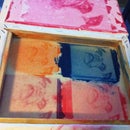Introduction: Wood and Polymer Clay IPad Stylus
Our hackerspace has a micro lathe that's a perfect size for turning a wooden stylus. Some people have made a couple already, but it's time for more members to have a chance to make them.
Touch screens like on the iPad need something conductive connecting from your finger to the glass. Many people absolutely hate the way a rubber tipped stylus will drag across the screen, so we'll be using conductive foam. It glides much more easily, making drawing and game playing so much more fluid.
A wood stylus looks neat. A wood stylus with various dots in a colorful gradient is even cooler.
Items used:
hardwood turning blank, a couple inches longer than the finished stylus - this one is cocobolo, a type of rosewood
polymer clay in at least two different colors - we suggest Sculpey 3 or Sculpey Premo with Liquid Sculpey to mix into the clay
conductive thread
conductive foam
simple beeswax/mineral oil finish if you're not using a really oily wood
small amount of clear glue
Tools:
lathe (with appropriate carving tools)
small needle
dremel or drill with various very small bits
sandpaper, from 100 grit and up - extremely fine sandpaper like micro mesh is highly recommended (and you're wasting the beauty of exotic hardwood if you skip the superfine stuff, quite honestly - a quick coat of poly does not compare to a properly buffed, uncoated mirror finish)
bandsaw or other kind of cutting tool
Step 1: Turn the Wood
This isn't meant to be a tutorial on wood turning. Please observe proper safety precautions if you're using a lathe - eyewear, mask, etc.
We cut down the cocobolo into a narrow rectangular prism then attached it to the chuck on the lathe. Using the lathe tools, we smoothed out the wood into a cylinder, then added some contours to make the stylus more comfortable.
It's important for the tools to be sharp. Please ask someone trained in the woodshop before you start using the lathe, especially if you don't have your own tools. Josh is happy to share, but you'll need to have a demonstration first.
Use the guide first when you're chipping off the corners of the turning blank. The sound of the tool will change once it's a smooth cylinder. After it's rounded out, you can start shaping it the way you want. Use gentle, slow, controlled motions. Don't try to push the tool too hard into the wood or it could bite a chunk out of the wood. It's also dangerous if you gouge the wood too hard - the tool might fly out of your hand and hit something. The lathe does have an emergency shutoff - just push the red button on the top. It also turns off immediately if the plastic cover on the chuck gets lifted for any reason.
We then sanded it, using all the grits of sandpaper, once it was the desired shape.
Step 2: Drill Holes
This looks best with different sizes of holes. We had a set of dremel drill bits and first used a hand drill (in case the dremel wiggled or something - a hand drill is slow but stable) and then the dremel to drill holes in the wood while it was still on the lathe.
Most of the big holes were toward the large end of the stylus.
We drilled some holes as simple divets for decoration in the stylus. Too many holes all the way through could weaken the wood. The rest of the holes (especially the smaller ones) were drilled all the way through the stylus.
After the holes were drilled in the sides, the tail stock was pulled off the lathe so we could drill a hole in through the tip of the stylus, making it hollow.
Step 3: Mix Clay
Making gradients from polymer clay is easy.
Pick two colors - color A and color B. Mix a little bit of color A with a little bit of color B to get color C. Take a bit of color C (not all of it!) and mix that with a bit of color A. Take another bit of color C and mix it with color B. Keep them lined up so you can see if any steps of color are too much. If there's too much contrast between any two colors in your gradient, take a bit of each of those colors to make a third color in between them.
Keep doing this until you have small amounts of a nice gradient of clay.
Step 4: Add the Polymer Clay Inlay
If your clay is too firm, add a bit of liquid polymer clay to soften it. Sculpey Premo has a great firmness for detailed sculpting, but it's difficult to press firm clay into tiny holes like this. Sculpey 3 is soft enough to press into stylus holes with no problem.
Rub the clay into the holes you drilled. Wipe off any excess. We used the gradients in order so the stylus would fade from one color to another down its length.
Poke a tiny hole in the middle of each clay dot where the conductive thread will go.
Once you like how it looks, bake according to the directions on the package of polymer clay, usually for about 15 minutes at 270 degrees F.
Step 5: Sand and Finish
If you bake this at home, you probably have the luxury of not opening the toaster oven and finding that the lake of grease that someone had left there had crept up the aluminum foil you had made for your stylus, coated the wood, and left it dark and smelling of burned meatballs.
Also... whoever left that lake of grease in the toaster oven at the Transistor.... GROSS, DUDE.
Check to make sure none of the clay dots have fallen out. If they have, you can add more clay and re-bake. Use very fine sandpaper to smooth out the clay dots. If you're also trying to remove baked in meatball grease, you'll have to put the stylus on the lathe and use a lot of sandpaper. Good luck with that. Cut off the rough end of the stylus where the chuck on the lathe held it in place. Sand it smooth.
Once the stylus is smooth as it should be, cut a small piece of conductive foam. Remember that if the tip of your stylus is too small, the device likely won't pick it up very well. We've done some experimentation with different sizes for stylus tip, and this is about the smallest possible with conductive foam that's still responsive enough to be usable.
Use a small beading needle with the conductive thread. Poke it gently through one of the holes in the stylus and out the other side. Use a thin tweezers or a piece of bent wire to pull the loop of conductive thread out through the tip of the wood stylus while the ends of the thread are still going through the holes in the sides. Trim the thread so an inch is hanging out of the holes in the stylus, then repeat with all the holes that go completely through the wood.
Poke the needle through the side of the conductive foam tip you cut. Pull the thread so you have some on either side of the foam. Poke the thread through about 90 degrees from the first entry, and out again. Use the four threads coming from the sides of the foam tip and wrap them around the loops of conductive thread coming out of the empty tip of the wood stylus. Carefully tie them together without pulling the thread so much that it pulls out of the holes in the sides of the stylus completely.
Use a clay tool, toothpick, or whatever you can find to push the conductive thread inside the wooden stylus, then push the foam tip into the hole, so that half of it sticks out. Use a little clear glue around the edges of the foam if you're concerned about it falling out.
Carefully add a tiny bit of clear glue to the conductive thread hanging out of the holes in the sides of the stylus. Don't use glue that's too runny - or if you do, make sure it doesn't seep deep inside the stylus and coat some of the thread, preventing it from making contact with the foam tip. Once the glue is dry, snip off the extra thread. Use superfine sandpaper to sand it flush.
Cocobolo doesn't really need much, especially if you're using it for a stylus. Don't use anything that'll coat the conductive thread that you just sanded down (to remove any glue from the surface that should be touching your fingers). We've found that even shellac can interfere with contact on a wood stylus. Josh usually has some beeswax/mineral oil homemade compound at his desk, and it works well for finishing a wood stylus. If you can't find the finishing compound, ask someone trained in the wood shop and hopefully they can find it. Rub it on with a piece of cotton muslin. Wait a few minutes, then rub it off again.

Participated in the
Play With Clay Contest












